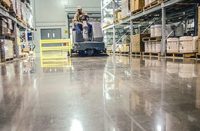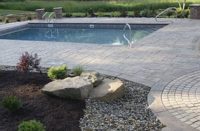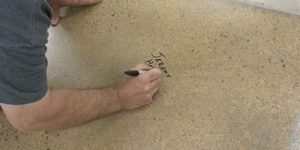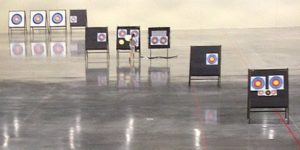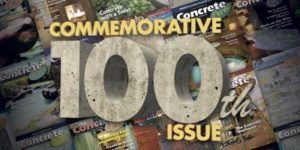In 2001, Colorado Hardscapes made a move that forever changed its approach to sales and marketing. The company moved into a new concrete design center, the first of its kind in Colorado. With racks of samples and slabs displaying the many decorative concrete options, the design center became one of the company’s most valuable resources.

It continues to evolve over time. Not only do the samples change regularly depending on current market trends and requests, but the space fluctuates with what the economy supports.
Yes, having a design center creates additional overhead costs, but the long-term return on investment exceeds the price. Designers use it as a resource to choose finishes and colors. Owners come and explore the possibilities. And Colorado Hardscapes even offers educational tours that can earn credit for members of the American Institute of Architects.
So what does it take to have a successful design center? A successful design center must:
- Show the options your company is comfortable installing.
- Be available to your clients.
- Provide take-aways for clients who visit.
- Show larger panels of installed examples.
- Be updated regularly.
Before we jump into what makes a design center successful, we need a definition: A decorative concrete design center is a facility or location that shows physical examples of decorative concrete options.
Secret #1: Show the options your company is comfortable installing.
This may sound like a no-brainer, but do not show examples of decorative concrete beyond your crews’ capabilities. On the flip side, be sure to show just about everything your company can successfully install.
At Colorado Hardscapes, we often get complaints about too many options, but we take it as a compliment rather than true criticism. Show enough colors and finishes in each of your product offerings to give a good snapshot of your company’s capabilities. You may be surprised at the many possibilities!
In our industry, there are endless options, so it’s easy to get carried away. In this instance, I think that’s OK — just be sure to organize the options. It’s easy for clients to feel overwhelmed with so many choices, but once they understand the groupings, they will be pleased and excited about the possibilities. If you want to explore a new finish or option you hope to develop further, have a section labeled “research and development.” Be honest with your clients about the newness of the finish.
Secret #2: Be available to your clients.
A design center is only valuable if it gets used. If your samples are strewn about collecting dust, they are worthless. Invite your clients into your design center. Any time they start asking about their options, take that opportunity to invite them to your location.
If you are opening a new concrete design center in your office, invite clients to an open house so they can see the resource. We have never had anyone regret taking the time to visit our design center. We now have several weekly design meetings in our facility because it is a known resource to the design community.
Another tactic is to offer educational courses at your facility. This will draw in people who earnestly want to know more about decorative concrete options. Offer this option to your residential market or a group of architects. Whatever your client base, they can find value in the design center.
Secret #3: Provide take-aways.
A design center is a great resource for ideas. But often, people gather ideas and samples first, and then need time to think about the colors and finishes. They may need to present their findings to a group or simply decide what color and texture looks best with the actual area’s surrounding finishes and architecture.
For these reasons, we provide take-aways, which include smaller samples clients can take home, as well as literature such as brochures and color charts. If you fear your samples will fall into the hands of a competitor, create a check-out system similar to that of a public library where samples need to be returned.
Regardless of how you inventory your take-aways, be sure everything in your show room is labeled and can be traced back to your company. At a minimum, every sample should have your company name on it. Also allow people to take pictures. I always smile when a client asks permission to take pictures at our design center. It sometimes feels like we’re a museum!
Secret #4: Show larger examples.
The take-away size is great for selecting finishes and colors, but larger examples are needed as well. We all know 12-inch samples may look nice, but they don’t always accurately represent the final installation.
The design center should be the first place where the process of managing expectations begins. The larger examples can be placed either inside or outside the design center, depending on available space. We have both interior and exterior displays, which we consider extremely valuable.
If you do not have space to install larger panels of your finishes, then I recommend compiling a list of addresses so interested clients can visit actual installations. You also should have binders full of project photos to show the options in installed settings.
The same theory behind having a design center backs up the importance of showing examples: Most clients are visual people.
Secret #5: Update regularly.
Since we are in the decorative concrete industry, it’s important to stay abreast of the industry’s changes and innovations. You should continually improve your design center by adding new options.
One way this naturally occurs is to include samples of specific client requests or recent custom jobs you’ve done. That’s where we get the majority of our samples.
If you don’t have anything new to offer, then rearrange and adjust your samples based on client interest. Your clients will give you the best feel of current trends and you can make it easier for others to find what they are seeking by prominently displaying those samples. By creating a diverse offering and keeping it fresh, you will provide value to clients and make them want to return time and time again when seeking new ideas.
With these five secrets of a successful decorative concrete design center, I hope you will find yourself and your company being the go-to resource when it comes to discovering the possibilities of decorative concrete. A design center is a valuable resource as it builds credibility, shows the options and offers tangible education.
